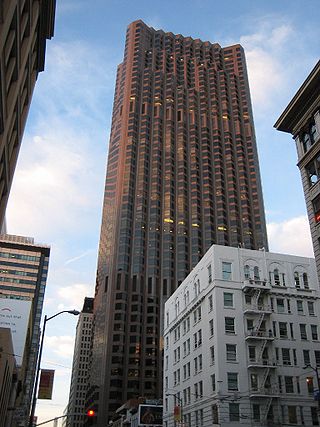
555 California Street, formerly Bank of America Center, is a 52-story 779 ft (237 m) skyscraper in San Francisco, California. It is the fourth tallest building in the city as of February 2021, and in 2013 was the largest by floor area. Completed in 1969, the tower was the tallest building west of the Mississippi River until the completion of the Transamerica Pyramid in 1972, and the world headquarters of Bank of America until the 1998 merger with NationsBank, when the company moved its headquarters to the Bank of America Corporate Center in Charlotte, North Carolina. It is currently owned by Vornado Realty Trust and The Trump Organization.
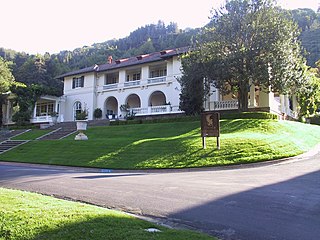
The Montalvo Arts Center is a non-profit center for the arts in Saratoga, California, United States. Open to the public, Montalvo comprises a cultural and arts center, a park, hiking trails and the historic Villa Montalvo, an Italian Mediterranean Revival mansion nestled in the foothills of the Santa Cruz Mountains. The mansion and estate were constructed from 1912 to 1914 by California statesman and businessman James Duval Phelan. After Phelan's death, the entire estate was donated to California as a park and then a cultural and arts center as it exists today. The arts center maintains the estate in partnership with Santa Clara County. The mansion is a historic landmark, and in 1978 it was awarded inclusion in the National Register of Historic Places.

The Financial District is a neighborhood in San Francisco, California, United States, that serves as its main central business district and had 372,829 jobs according to U.S. census tracts as of 2012-2016. It is home to the city's largest concentration of corporate headquarters, law firms, insurance companies, real estate firms, savings and loan banks, and other financial institutions. Multiple Fortune 500 companies headquartered in San Francisco have their offices in the Financial District, including Wells Fargo, Salesforce, and Gap.
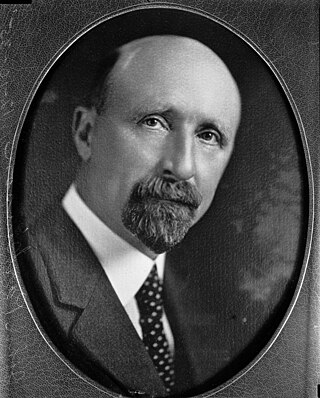
John and Donald Parkinson were a father-and-son architectural firm operating in the Los Angeles area in the early 20th century. They designed and built many of the city's iconic buildings, including Grand Central Market, the Memorial Coliseum, and City Hall.
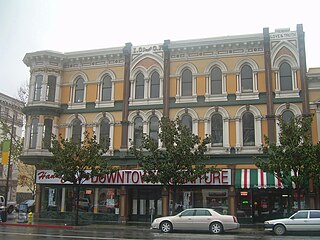
The Downtown Historic District of San Jose, California is a designated U.S. Historic District area of the city roughly the size of one square block. It is bounded by S. First Street to the west, E. San Fernando Street to the south, S. Third Street to the east, and E. Santa Clara Street to the north, but also includes the south side of E. Santa Clara Street between Third and Fourth Streets.
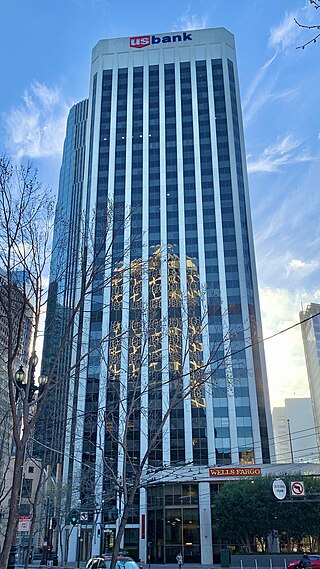
One California is a 133.5 m (438 ft), 32-story office skyscraper completed in 1969 in the Financial District of San Francisco, California. It is the 31st-tallest building in the city. The architect of the building was Welton Becket Associates.

Central Tower is a 91 m (299 ft) 21-story office building at Market and Third Streets in San Francisco, California. The building has undergone numerous renovations since its completion in 1898 as the Call Building. It was later known as the Spreckels Building.
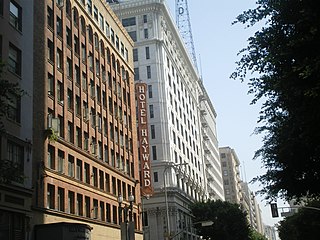
Spring Street in Los Angeles is one of the oldest streets in the city. Along Spring Street in Downtown Los Angeles, from just north of Fourth Street to just south of Seventh Street is the NRHP-listed Spring Street Financial District, nicknamed Wall Street of the West, lined with Beaux Arts buildings and currently experiencing gentrification. This section forms part of the Historic Core district of Downtown, together with portions of Hill, Broadway, Main and Los Angeles streets.
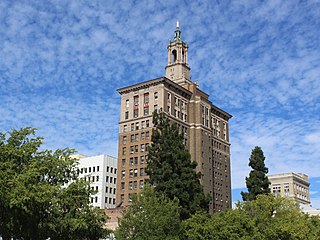
The Bank of Italy Building is a 14-story, 77.72 m (255.0 ft) Renaissance Revival high-rise office building on the corner of South First Street and Santa Clara Street in downtown San Jose, California. Built in 1925–26 as San Jose's first skyscraper, it has a red-tile hip roof and a decorative cupola with a needle-like spire featuring a tall green light. It is a designated San Jose Historical Landmark and part of the Downtown Historic District.
Mowbray & Uffinger comprised an architectural partnership in New York City formed in 1895. Known for bank buildings and as vault engineers they designed over 400 banks in the pre-World War II era throughout the country. The principals were Louis Montayne Mowbray (1867-1921) and Justin Maximo Uffinger Sr. (1871-1948).

Mid-Market is a neighborhood, historic district and development area in San Francisco, California. The neighborhood is bounded by Market Street to the north, 5th Street to the east, Mission Street to the south, and Van Ness Avenue to the west. There are many theaters in the district, most of which began as vaudeville theaters, include the Warfield and Golden Gate.

William F. Curlett and Alexander Edward Curlett were a father-and-son pair of architects. They worked together as partners under the name of William Curlett and Son, Architects from c. 1908–1916. Aleck Curlett partnered with Claud Beelman as Curlett & Beelman (1919–1932).
Walter Danforth Bliss (1874-1956) was an American architect from California. Many of his buildings are listed on the National Register of Historic Places.

The Ritz-Carlton Club and Residences is a 312-foot (95 m) luxury residential skyscraper in the Financial District of San Francisco, California. The residences are built atop the historic Old Chronicle Building, sometimes called the de Young Building, which was constructed in 1890. It is the first skyscraper built in California.

The Phelan Building is an 11-story office building located at 760 Market Street in the Financial District of San Francisco, California. It has a triangular shape, similar to the Flatiron Building in Manhattan, New York City, with its tip at the meeting point of Market Street, O’Farrell Street, and Grant Avenue. It is a San Francisco Designated Landmark.

George Haas & Sons was a confectioner in San Francisco, California. George Haas established his first candy factory and store, where he made some 200 varieties of candies, in 1868. After selling the business in 1880 he opened a new business two years later in the Phelan Building, designed by William Curlett, which was marketed as the most beautiful candy store in the U.S. and featured on an historic postcard.

7th Street is a street in Los Angeles, California running from S. Norton Ave in Mid-Wilshire through Downtown Los Angeles. It goes all the way to the eastern city limits at Indiana Ave., and the border between Boyle Heights, Los Angeles and East Los Angeles.
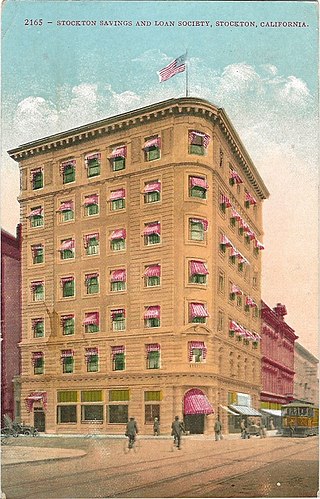
Stockton Savings and Loan Society Bank is a historic commercial building completed in 1908. It is located on 301 East Main Street in Stockton, California. The landmark was added to the National Register of Historic Places on October 19, 1978.

The Mutual Life Building, originally known as the Yesler Building, is an historic office building located in Seattle's Pioneer Square neighborhood that anchors the West side of the square. The building sits on one of the most historic sites in the city; the original location of Henry Yesler's cookhouse that served his sawmill in the early 1850s and was one of Seattle's first community gathering spaces. It was also the site of the first sermon delivered and first lawsuit tried in King County. By the late 1880s Yesler had replaced the old shanties with several substantial brick buildings including the grand Yesler-Leary Building, which would all be destroyed by the Great Seattle Fire in 1889. The realignment of First Avenue to reconcile Seattle's clashing street grids immediately after the fire would split Yesler's corner into two pieces; the severed eastern corner would become part of Pioneer Square park, and on the western lot Yesler would begin construction of his eponymous block in 1890 to house the First National Bank, which had previously been located in the Yesler-Leary Building. Portland brewer Louis Feurer began construction of a conjoined building to the west of Yesler's at the same time. Progress of both would be stunted and the original plans of architect Elmer H. Fisher were dropped by the time construction resumed in 1892. It would take 4 phases and 4 different architects before the building reached its final form in 1905. The Mutual Life Insurance Company of New York only owned the building from 1896 to 1909, but it would retain their name even after the company moved out in 1916.

John P. Gaynor was an Irish American architect practicing in New York City and San Francisco during the nineteenth century.

























